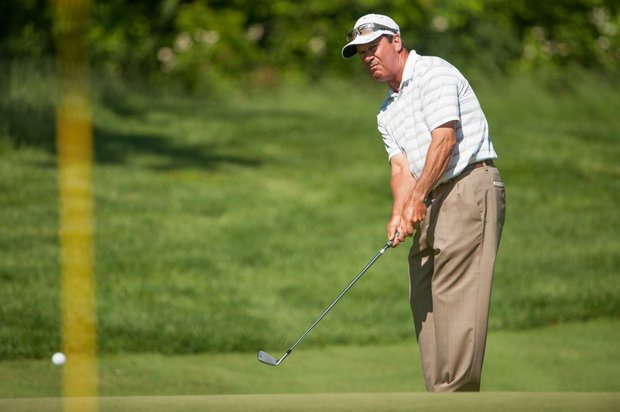Instruction
DeFrancesco: Golf is a Technique Game

My love affair with swing technique really started when, after a series of back surgeries, I decided that I had to change my swing if I were going to continue playing competitive golf at the professional level.
I realized that my upright backswing and bent back finish needed to be a flatter, more rounded motion that ended up with my upper body more on top of my lower. I began to study Ben Hogan, and to this day, the videos of his swing and the instructional books he authored are the foundation of my own teaching preferences. The instruction I give is also the result of having continued to pursue playing at the highest level of competition while maintaining a busy teaching schedule at a private club.
I have taught the game to players of all levels from beginner to Tour player. Today, most people who have worked with me directly or that know me through my online instructional videos should be familiar with my teaching philosophy. Summarized, I believe that golf is really a technique game in which a good swing hits good shots and you need to hit enough good shots to compete and perhaps win. And by “good” I mean “effective,” which applies to all swings, including pitching and putting.
Golf is a Hard Game
There are a few things that might set my teaching apart from what one might consider conventional. For one, I believe that there are no quick fixes when it comes to improving swing technique. Every change affects something else. While it is possible that one idea may cause other things to fall into place, it just as likely that one change may mess other things up and create even more problems. Therefore, it is very important to have an understanding of how any attempted change will affect other areas of the swing.
Second, I believe that most changes need to be combined with another change in order for any of it to work. I realize that “keeping it simple” is one of the great buzz phrases of the teaching industry, but the game is truly complex and there is really no way to keep it simple. Unless, of course, you have been blessed with incredible talent and can do things correctly without much conscious thought. If you are like me and don’t fall into the category, you should find comfort in knowing that players having that level of talent are extremely rare.
It is hard to be a beginner and it’s hard to get to the next level, no matter what level you’re on. When you finally think you’ve “got it,” it can quickly and mysteriously leave you, for no good reason other than you went to bed and woke up the next day. I know this because I have been playing competitive golf since I was 12 and I have been teaching golf to every imaginable level of student for 27 years. In my career, I have left the game three times, twice due to injury and once for poor play. Each time I was lured back inside of two years and I have realized that there is really no way around the fact that I am a golfer for life.
Developing Good Technique is Physically Demanding
My goal, as it is with all my students, is to provide readers with an honest perspective of the game gleaned from my many years of experience and to offer information and direction to those seeking to improve. One thing you won’t get from me is a promise that anything I say will cause you to improve instantaneously, unlike most teaching methods which spout the same message:
“This (whatever method) will have you hitting the ball better instantly!”
Of course, we all know this is rubbish, but boy do we want to believe that it’s true. Unfortunately, the process of improving one’s technique is long and arduous. It is full of pitfalls, plateaus, and then, perhaps, if you are fortunate, the odd, exhilarating moment when things finally do fall into place and don’t disappear.
There are a few technique items that I emphasize in my teaching that you may find different from the norm. For one, I don’t believe that “maintaining your posture” is the best way to think of pivot movement. Rather, I would like to see my students lower both in the backswing and in transition, just as video evidence proves that a majority of great players past and present have done. I have covered using the ground (what I refer to as pivot compression) extensively in my swing analysis videos in which it is shown to be a common trait of good ball strikers even though they may appear to have very different looking swings. Another unconventional preference of mine (also used by many of the best players) is to have the hands travel outward toward the ball in their first movement in the change of direction, while the shaft of the club kicks back or shallows. This combination sidearm and underhand motion, as Hogan referred to it in his book “The Five Lessons,” is the key to the overall feel and athletic conception of the movement of the golf swing. Hogan put four different examples of this elbow first throwing motion in his book, which to me is proof of his belief in its importance.
The True Test of Technique Is Under Pressure
It is easy to pontificate about the swing and all the various facets of the game if you don’t have to take your theories out onto the course and put them into action. Golf is a truly fascinating game in that there is incredible variation in the techniques that have been used to by the greatest players of all time. Some of them have what may be described as classic swings that follow all of the rules of physics and geometry that a century of study has deemed correct, while others seem to break every one of these rules, which of course means that there are very few real rules that need to be followed. Having done slow-motion video swing analyses of well over 100 past and present Tour players, the thing that stands out the most is just how differently each one of these players achieved their success, although there are enough commonalities among this wide range of swings that we can form an idea of just what is an effective way to move the club through impact for those who are not already blessed with a knack for hitting the ball.
I look forward to contributing to this column each month and you can expect original and thought provoking pieces to be forthcoming. I also hope that you will be enticed to further explore my teaching. My desire and mission is to educate and offer direction to those who are seeking a better understanding of the game. If you come back to look for more of my work here I can promise you that I will be doing my best to give you useful information.
- LIKE15
- LEGIT1
- WOW1
- LOL1
- IDHT1
- FLOP1
- OB1
- SHANK1
Instruction
Clement: Laid-off or perfect fade? Across-the-line or perfect draw?

Some call the image on the left laid off, but if you are hitting a fade, this could be a perfect backswing for it! Same for across the line for a draw! Stop racking your brain with perceived mistakes and simply match backswing to shot shape!
- LIKE0
- LEGIT0
- WOW0
- LOL0
- IDHT0
- FLOP0
- OB0
- SHANK0
Instruction
The Wedge Guy: The easiest-to-learn golf basic

My golf learning began with this simple fact – if you don’t have a fundamentally sound hold on the golf club, it is practically impossible for your body to execute a fundamentally sound golf swing. I’m still a big believer that the golf swing is much easier to execute if you begin with the proper hold on the club.
As you might imagine, I come into contact with hundreds of golfers of all skill levels. And it is very rare to see a good player with a bad hold on the golf club. There are some exceptions, for sure, but they are very few and very far between, and they typically have beat so many balls with their poor grip that they’ve found a way to work around it.
The reality of biophysics is that the body moves only in certain ways – and the particulars of the way you hold the golf club can totally prevent a sound swing motion that allows the club to release properly through the impact zone. The wonderful thing is that anyone can learn how to put a fundamentally sound hold on the golf club, and you can practice it anywhere your hands are not otherwise engaged, like watching TV or just sitting and relaxing.
Whether you prefer an overlap, interlock or full-finger (not baseball!) grip on the club, the same fundamentals apply. Here are the major grip faults I see most often, in the order of the frequency:
Mis-aligned hands
By this I mean that the palms of the two hands are not parallel to each other. Too many golfers have a weak left hand and strong right, or vice versa. The easiest way to learn how to hold the club with your palms aligned properly is to grip a plain wooden ruler or yardstick. It forces the hands to align properly and shows you how that feels. If you grip and re-grip a yardstick several times, then grip a club, you’ll see that the learning curve is almost immediate.
The position of the grip in the upper/left hand
I also observe many golfers who have the butt of the grip too far into the heel pad of the upper hand (the left hand for right-handed players). It’s amazing how much easier it is to release the club through the ball if even 1/4-1/2″ of the butt is beyond the left heel pad. Try this yourself to see what I mean. Swing the club freely with just your left hand and notice the difference in its release from when you hold it at the end of the grip, versus gripping down even a half inch.
To help you really understand how this works, go to the range and hit shots with your five-iron gripped down a full inch to make the club the same length as your seven-iron. You will probably see an amazing shot shape difference, and likely not see as much distance loss as you would expect.
Too much lower (right) hand on the club
It seems like almost all golfers of 8-10 handicap or higher have the club too far into the palm of the lower hand, because that feels “good” if you are trying to control the path of the clubhead to the ball. But the golf swing is not an effort to hit at the ball – it is a swing of the club. The proper hold on the club has the grip underneath the pad at the base of the fingers. This will likely feel “weak” to you — like you cannot control the club like that. EXACTLY. You should not be trying to control the club with your lower/master hand.
Gripping too tightly
Nearly all golfers hold the club too tightly, which tenses up the forearms and prevents a proper release of the club through impact. In order for the club to move back and through properly, you must feel that the club is controlled by the last three fingers of the upper hand, and the middle two fingers of the lower hand. If you engage your thumbs and forefingers in “holding” the club, the result will almost always be a grip that is too tight. Try this for yourself. Hold the club in your upper hand only, and squeeze firmly with just the last three fingers, with the forefinger and thumb off the club entirely. You have good control, but your forearms are not tense. Then begin to squeeze down with your thumb and forefinger and observe the tensing of the entire forearm. This is the way we are made, so the key to preventing tenseness in the arms is to hold the club very lightly with the “pinchers” — the thumbs and forefingers.
So, those are what I believe are the four fundamentals of a good grip. Anyone can learn them in their home or office very quickly. There is no easier way to improve your ball striking consistency and add distance than giving more attention to the way you hold the golf club.
More from the Wedge Guy
- The Wedge Guy: Golf mastery begins with your wedge game
- The Wedge Guy: Why golf is 20 times harder than brain surgery
- The Wedge Guy: Musings on the golf ball rollback
- LIKE86
- LEGIT13
- WOW6
- LOL1
- IDHT0
- FLOP4
- OB1
- SHANK8
Instruction
Clement: Stop ripping off your swing with this drill!

Not the dreaded headcover under the armpit drill! As if your body is defective and can’t function by itself! Have you seen how incredible the human machine is with all the incredible feats of agility all kinds of athletes are accomplishing? You think your body is so defective (the good Lord is laughing his head off at you) that it needs a headcover tucked under the armpit so you can swing like T-Rex?
- LIKE0
- LEGIT2
- WOW2
- LOL0
- IDHT0
- FLOP0
- OB0
- SHANK2
-

 19th Hole2 weeks ago
19th Hole2 weeks agoDave Portnoy places monstrous outright bet for the 2024 Masters
-

 19th Hole3 days ago
19th Hole3 days agoJustin Thomas on the equipment choice of Scottie Scheffler that he thinks is ‘weird’
-

 19th Hole2 weeks ago
19th Hole2 weeks agoTiger Woods arrives at 2024 Masters equipped with a putter that may surprise you
-

 19th Hole3 days ago
19th Hole3 days ago‘Absolutely crazy’ – Major champ lays into Patrick Cantlay over his decision on final hole of RBC Heritage
-

 19th Hole3 weeks ago
19th Hole3 weeks agoReport: Tiger Woods has ‘eliminated sex’ in preparation for the 2024 Masters
-

 19th Hole1 week ago
19th Hole1 week agoTwo star names reportedly blanked Jon Rahm all week at the Masters
-

 19th Hole1 week ago
19th Hole1 week agoReport: LIV Golf identifies latest star name they hope to sign to breakaway tour
-

 19th Hole1 week ago
19th Hole1 week agoNeal Shipley presser ends in awkward fashion after reporter claims Tiger handed him note on 8th fairway















Matt Newby, PGA
May 23, 2013 at 1:00 pm
Wayne,
Very well said, several things that people need to understand before they even consider taking lessons. That being said your concept of “pivot compression” is unfortunately not something a lot of instructors understand in my experience. If you want to do some good research on this topic the biomechanics world refers to it as spinal extension and flexion. If you do some research on these topics you can find some great examples of using it in other sports that have really helped my students. Keep the good articles coming.
Darren
Oct 15, 2013 at 10:41 am
So what do you think of the stack and tilt technique
HB
May 21, 2013 at 8:40 pm
The link to your DVD isn’t working 🙁
nick
May 18, 2013 at 1:55 pm
can i presume that if you think one should lower in the backswing and the transition…one should get taller through impact, or something along this line of thinking? Thank You
wayne defrancesco
May 19, 2013 at 6:54 pm
Yes, that is correct. The sequence is down a bit in the backswing, down more in transition to left arm parallel, stable to shaft parallel, then up into impact. The up would be due to the squeezing and pushing of the glutes through impact while maintaining a good deal of the right side bend created by the lateral movement of the hips.
Joel
May 17, 2013 at 3:47 pm
Wayne,
Glad to see you are writing articles for GolfWRX. I’ve been following your Golf Instruction for a few years.
wayne defrancesco
May 19, 2013 at 6:50 pm
Thanks! I look forward to being a regular contributor to GolfWRX.